How to Make a Telemedicine App: Features, Costs and Trends
07 Mar 2024
18 Min
197 Views
With the rise of digital innovation, telehealth apps have emerged as a powerful tool in transforming the delivery of healthcare services. The question medical business owners are asking is how to build a telehealth application, as a deep understanding of this process guarantees success.
We at Cleveroad have over 12 years of experience in telemedicine software development. In this article, we will tell you about the steps to develop a telehealth app, the features to include, and the cost of building such a solution.
Why There Is a Need for Building Telemedicine Platform
Building a telemedicine platform allows you to solve many problems and challenges related to the provision and receipt of medical services. Thus, telehealth applications significantly improve the experience of both patients and healthcare providers. Let's look at some of the most important benefits of building a telemedicine app.
Benefits for patients
By deciding to develop a telehealth app, you can help patients digitize and simplify the following tasks:
- Receiving medical care. Telemedicine apps allow patients to receive expert medical care without being physically present at a medical facility. This is especially useful if they have limited mobility or access to health services.
- Time and resource savings. With telehealth apps, patients can reduce the time and costs of traveling to the doctor's office and avoid long waiting lines, making it more affordable and convenient to receive medical care in the telehealth market.
- Health monitoring. Telemedicine applications allow patients to monitor their health indicators, such as pulse or blood glucose levels, which helps them manage their health more effectively.
- Access to specialists. Telehealth applications allow to book an appointment with specialists in various medical fields, helping patients receive expert advice and diagnosis at their convenience and improving doctor and patient interaction.
Benefits for healthcare providers
Building telemedicine platform also greatly helps healthcare providers in many key tasks. Here are main benefits of telemedicine apps:
- Expanding the patient base. Telemedicine platforms help healthcare providers to attract more patients and expand their customer base by providing global telemedicine services online.
- Improving accessibility and efficiency. With the help of telemedicine applications, providers can improve the accessibility of healthcare services to patients by enabling them to receive real-time consultations and diagnostics, providing leadership in global telemedicine market.
- Operational optimization. Use of telemedicine apps help providers optimize their schedules and manage time more efficiently, which increases productivity and reduces the burden.
- Better health care. With the help of telemedicine apps, providers can provide more personalized and continuous medical care, which improves patient satisfaction and quality of telehealth services.
Creating a telemedicine app helps address the challenges of accessibility and quality of healthcare and allow the benefit from telemedicine app development for patients and healthcare providers.
Explore our telemedicine software development services to find out how we can help you in developing telehealth solution to enhance caregiving and improve your clinics efficiency
Core Features to Include in Telehealth Application
How to build a telehealth application? First of all, it is important to understand that telemedicine software development implies the creation of three modules:
- App for patients
- App for healthcare providers
- Admin panel
Each app contains several must-have features of a telehealth app necessary for its proper work. Let's learn how to develop a telehealth application with the essential functionality:
Patient side features
The patient interface in a telemedicine application provides convenient access to medical services anywhere. Essential functionality for a telehealth app from the patient's side includes:
Secure new patient registration module. Patients can create their accounts in the app by filling in personal information and contact details. To ensure security, make sure registration meets all the requirements of domain regulations in your region (e.g., HIPAA, GDPR, PIPEDA, etc.). Also, ensure that the registration module has industry-standard data encryption protocols.
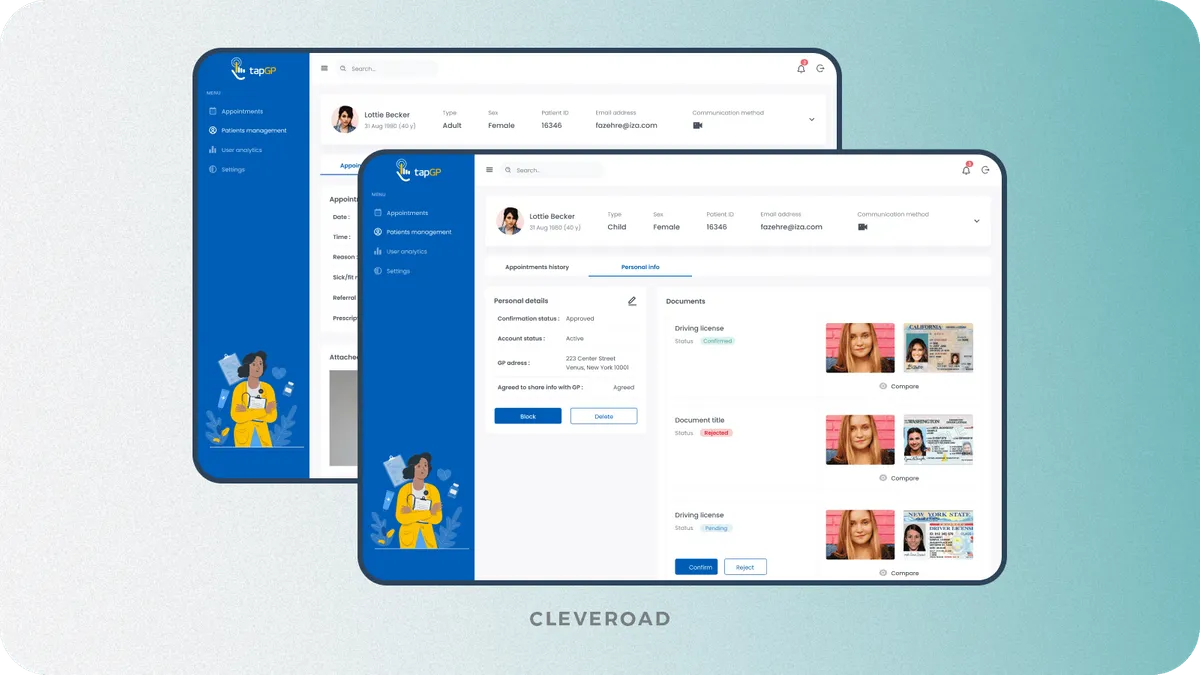
New patient registration feature with KYC procedures example developed by Cleveroad
Patient dashboard. In the patient dashboard, patients can view their medical history, test results, prescriptions, and doctor recommendations. They can monitor their health and get up-to-date information about their condition via the app.
Profile management. Patients can edit their personal information, update their medical information, set notification preferences, and manage their profile in the app. This patient app feature helps them keep their information and app settings up to date.
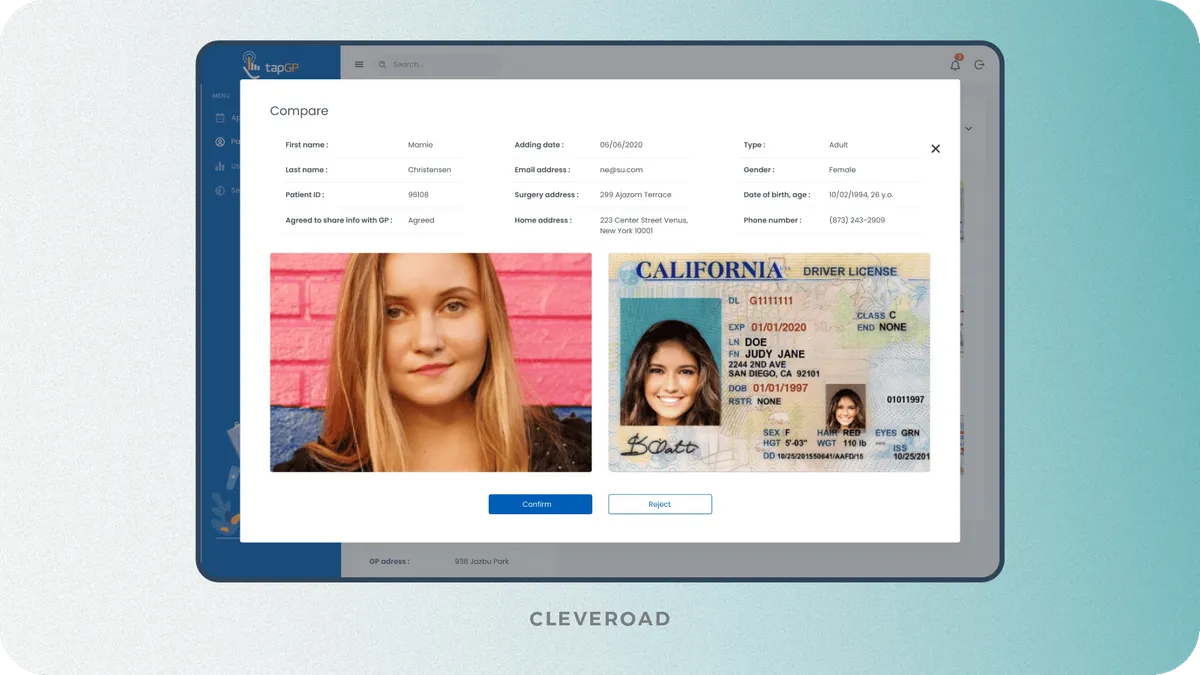
Patient profile feature example created by Cleveroad
Appointments. Patients can view available times and make appointment with a doctor through the app. They can choose the therapist they want to visit, set a convenient time, even at the same day, book an appointment and receive confirmation notification.
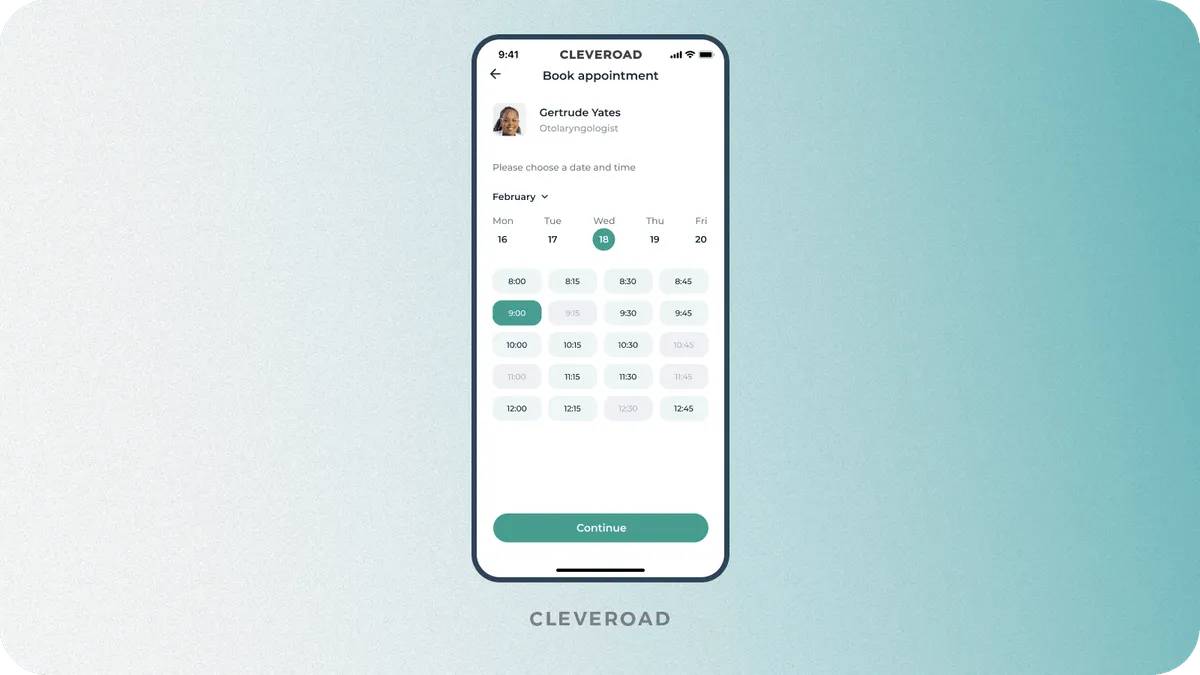
Appointment scheduling feature example designed by Cleveroad
Rating system. After each appointment with a provider, patients can leave feedback and ratings about the quality of care. This helps other patients choose the best providers and improves the care quality.
Search and filters. Patients can use the search and filters feature to find the right doctor or specialist. They can select providers based on specialty, location, rating, and other parameters.
Payment details. In the app, patients can view information about consultation fees, pay for medical services, and receive payment receipts. This telemedicine app feature provides transparency and convenience in paying for medical services.
Communication. Patients can communicate with doctors through text chats or video consultations, ask questions, get recommendations, and share their concerns. This helps establish a strong connection between patient and provider.
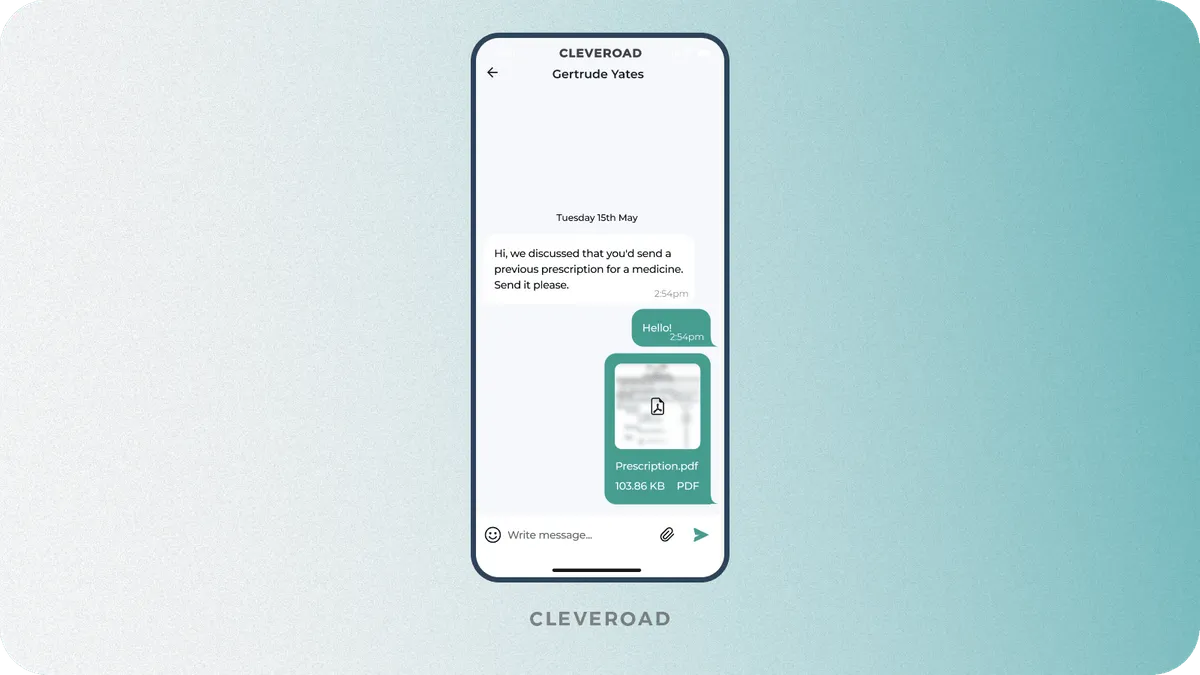
In-app communication feature example developed by Cleveroad
Notifications. The app sends notifications about upcoming appointments, test results, medication reminders, and other important information. This helps patients stay informed about their treatment and adhere to doctors' recommendations.
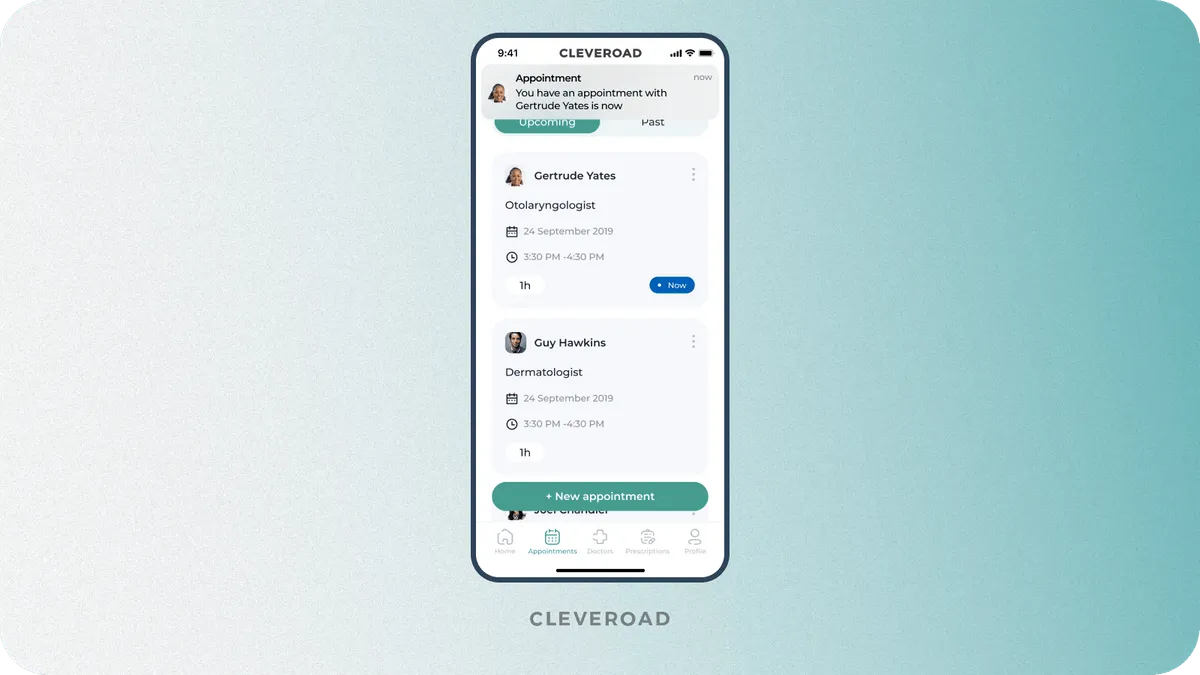
Example of notifications feature designed by Cleveroad
Healthcare provider side features
The healthcare provider interface is essential for enabling efficient delivery of medical services, facilitating patient management, and ensuring seamless communication. Essential functionality for a telehealth app from the healthcare provider’s side includes:
Healthcare provider dashboard. It is a centralized hub where medical professionals can access vital patient information, manage appointments, view treatment histories, and track progress seamlessly.
Appointment scheduling management. Physicians should be able to manage their patient appointment schedules through the app. This feature of the solution for doctors includes adding new appointments and canceling or modifying existing appointments.
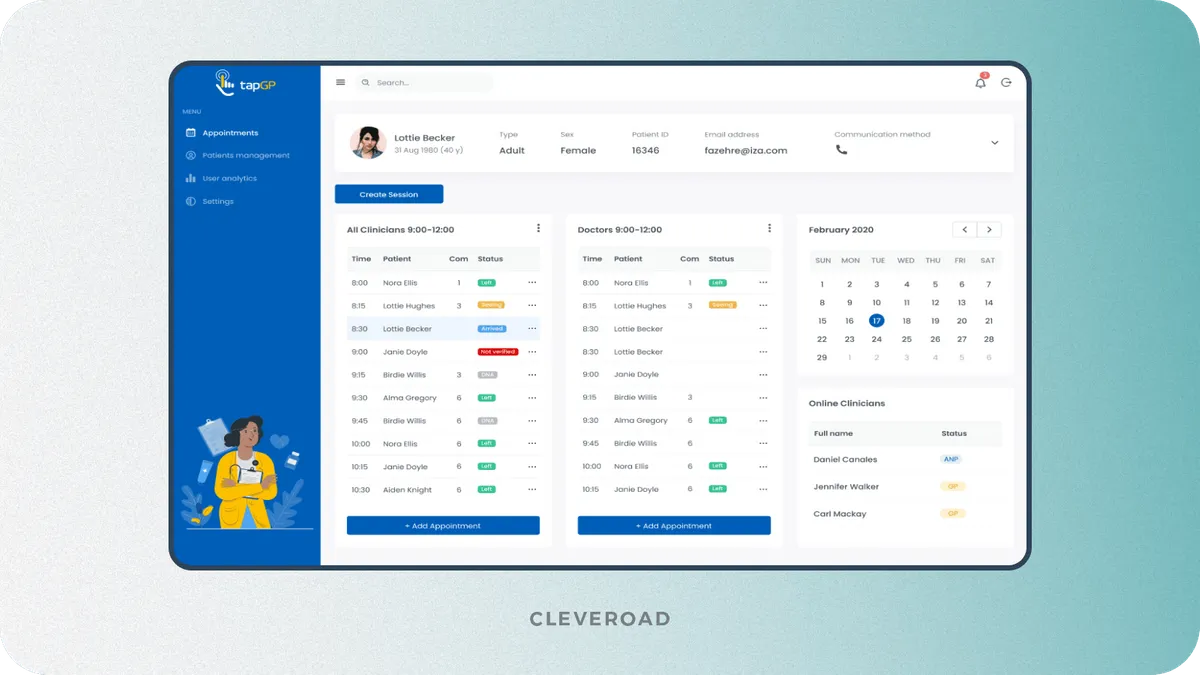
Appointment management feature example designed by Cleveroad
Physician profile. Each provider has a profile that displays information about their specialty, certifications, experience, and feedback from patients. This helps patients choose the right doctor and evaluate their qualifications via an app.
Conferences and chats. Physicians can consult and discuss medical issues with colleagues or patients via video conferencing or text chats providing telehealth services. This allows for easy communication and information sharing among members of the medical team.
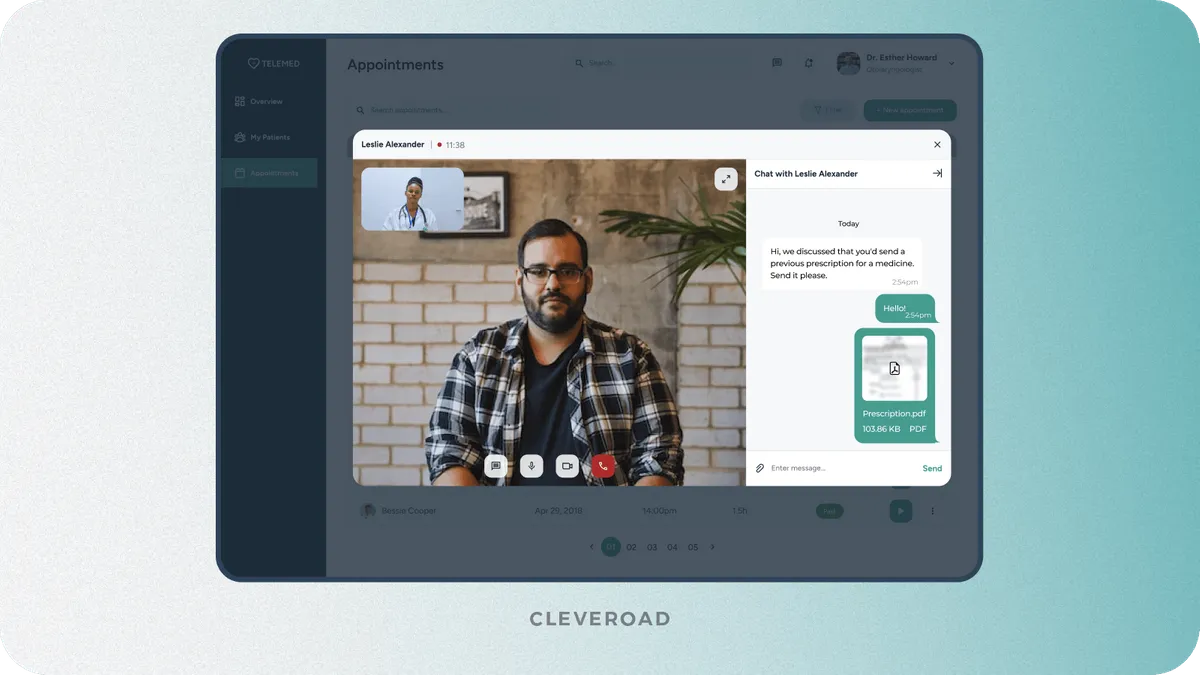
Conferences and chat functionality example created by Cleveroad
Electronic Hedical Records (EHR) access. Physicians can create, update, and review patient medical records through the app. This allows them to efficiently keep track of medical information and ensure proper maintenance of medical records.
Read our detailed guide on how to create EHR system to learn all the essential steps and critical functionality
Prescription administration. Physicians can prescribe prescriptions and manage patients' drug therapy right within the app. This feature ensures quick and easy prescribing of medications and monitors patient's medication adherence.
Note: If you need a separate solution to manage prescriptions, read our detail guide about e-prescription app development to learn more.
Admin panel
The administrative panel for a telemedicine platform is a centralized tool designed to manage all aspects of the system. Its purpose is to provide system administrators with the ability to manage users, access, content, payments, analytics, and other key functions. The admin panel ensures control and efficient operation of the platform, maintaining its functionality and security while also providing a high level of service for all participants.
Cost to Build Telemedicine App
On average, the cost to develop a telehealth app ranges from $150,000 to $300,000+. However, this amount can vary due to many factors. Let's take a closer look at those that most affect the price of building a telemedicine platform:
Number and complexity of features
The more features you want to include in your telemedicine app, the higher the development costs. For example, if you plan to build a telemedicine application with only basic features, the price will be lower than if you add advanced features. Here's a quick breakdown of how the cost of creating a telemedicine app can vary depending on complexity:
Simple telemedicine solution: $150,000 - $200,000
A basic telemedicine solution offers essential features like secure video calls, appointment scheduling, and messaging tools for patient-provider communication. It's designed to make remote consultations easy and accessible for both patients and healthcare providers.
Medium complexity telemedicine solution: $200,000 - $250,000
With a medium complexity telemedicine solution, you get additional features like real-time vital sign monitoring, patient portals for accessing medical records, and integration with wearable health devices. This level of solution caters to more diverse needs and provides a more comprehensive telemedicine.
Complex telemedicine solution: $250,000 - $30,000+
A complex telemedicine solution is highly sophisticated and customizable, suitable for larger healthcare organizations or specialized practices. It includes advanced functionalities such as tele-ICU capabilities, virtual care coordination tools, and AI-driven decision support systems. While it comes at a higher cost, it offers extensive flexibility and functionality for delivering comprehensive virtual care services.
Want to know more about telemedicine app development cost? Read our comprehensive guide to learn about all cost-driving factors
Selected platform
Choosing a platform (iOS, Android, web, or all of them) also affects the telemedicine app development cost. Each platform requires separate development, testing, and support, which increases the overall cost. For example, if you want to build a mobile telemedicine app for both platforms, it will cost more than developing telehealth app for iOS or Android. Depending on the choice of platform, the cost to develop a telemedicine app from scratch can be:
- One platform (iOS or Android): $100,000 - $175,000
- Two platforms (app for iOS and Android): $175,000 - $250,000
- Two platforms + Web solution: $250,000 - $300,000+
Note: If you want to make your app accessible for two platforms, you can turn to Flutter app development services to create a telemedicine app faster and cut costs by up to 50%.
Location of the healthcare development team
The cost of telemedicine application depends on the development team members rates in different regions of the world. Here are some of the most popular areas to hire telehealth application development company and their hourly wages:
- Central and Eastern Europe: $40-$80
- Western Europe: $80-$120
- USA: $100-$150
- India: $25-$50
- Australia: $100-$150
Developers from the United States and Western Europe typically have higher rates, but this doesn't always translate to superior quality. It's crucial to exercise caution when selecting a company.
On the other hand, developers from India often offer the lowest rates. Still, such collaborations may come with particular nuances, such as significant differences in time zones and cultural mentalities, which may not be convenient for everyone.
Central and Eastern Europe (CEE) stands out as one of the most optimal regions to outsource healthcare software development. It offers a balanced ratio of price and quality, with fewer significant differences in time zones and cultures compared to other regions.
Design complexity
The design's level of detail and complexity also affect the overall development cost. If you need a simple and minimalistic design, it will cost less than developing a complex UI with animations, customized design elements, and an adaptive interface.
Cleveroad’s Successful Cases on Delivering Telehealth Apps
To familiarize you with our expertise in telehealth, we will present you with several successful cases of building telemedicine platforms for our clients.
Telemedicine system with appointment scheduling
Our client, a UK-based provider of healthcare consultations, approached us for help building a telemedicine system to provide and receive health services online.
To meet the customers' business needs, we built a custom telemedicine system containing all the necessary app functionality for scheduling appointments (including day-to-day), conducting online doctor-patient sessions, and other related tasks. Our experts have also implemented robust security measures, including role-based access and Know-Your-Customer (KYC) procedures. The solution fully complies with all UK healthcare regulations, including GDPR, CQC, and MHRA.
As a result, the client received a ready-to-use telehealth platform that allowed the customer to reduce manual operations, improve performance discipline, and reduce paperwork by 5-20%.
- Explore our Telemedicine system with appointment scheduling case in detail
IoT system for monitoring ECG and blood oxygen levels
Our client, a US-based manufacturer of ECG heart monitoring devices and pulse oximeters, approached us to create software that would allow users of their devices to track collected metrics on their phones.
To address client business needs, we built a mobile telecare solution from scratch integrated with IoT devices. We ensured constant connection of customer's devices with an app via Bluetooth. The application receives and processes data and gives users collected information about their metrics. Our team ensured 510(k) FDA Medical Device Registration and HIPAA compliance to allow the app to store and process Personal Health Information (PHI) data.
As a result, our client received iOS and Android telehealth mobile applications that provide users with valuable opportunities to track vital signs. Reviews confirm the high quality of the solution: 95% of users rate it with "4-5 stars". The app also receives positive feedback from doctors.
- Explore our IoT system for monitoring ECG and blood oxygen levels case in detail
Therapy services ecosystem with EHR integration
Our customer is a US-based provider of mental healthcare services who approached us with a request to build a fully automated telehealth system. The system must also be integrated with the existing solution and support referral management according to the client's business model.
To address the client's needs, we created a robust and fault-tolerant telehealth platform that optimizes the booking and managing of online appointments and provides the functionality of online appointments and a direct chat between patients and providers. We also integrated the telemedicine system with the client's existing EHR, ensuring a seamless flow of information. Also, our experts ensured reliable data synchronization and system HIPAA compliance.
As a result, our customer received a bespoke telemedicine system that allowed the client to automate existing business processes and master the healthcare niche. The comprehensive functionality across mobile and web applications, along with the Admin panel, enabled the creation of a unified platform, delivering an optimal digital experience for all users.
- Explore our Therapy services ecosystem with EHR integration case in detail
How to Create a Telehealth App Step-by-Step
Building a telemedicine platform is a complex process that requires careful planning and consistent execution. Telehealth app development process involves several key steps. In this section, we will tell you how to create a telehealth app on the example of our Software Development Life Cycle (SDLC).
Step 1. First contact
Once you submit a request on our website, our business development department specializing in health technology responds within 24 hours. Your personal manager, with relevant experience in healthcare, will contact you to discuss the initial details of building a telemedicine platform tailored to your needs. We also sign a non-disclosure agreement (NDA) upon your request to ensure confidentiality and your project idea protection.
Step 2. Solution Workshop stage
The Solution Workshop stage is dedicated to aligning your business requirements for creating a telemedicine app with technical implementation. In this phase, healthcare IT experts analyze your requests, define the functional scope, and propose suitable technical solutions to build a telehealth app. We also consider your possible constraints, such as development timelines, budget constraints, and collaboration preferences, ensuring a customized approach to your telehealth project.
At the end of the Solution Workshop phase we provide a comprehensive proposal. It includes:
- Healthcare value stream diagrams
- A high-level telehealth feature list
- Telemedicine system architecture diagrams
- Team composition for telemedicine app development
- Technology stacks optimized for telemedicine
- Approximate telehealth app development cost
Step 3. Discovery Phase
During the Discovery Phase, Cleveroad assists in shaping your telehealth app by refining project requirements into a clear plan, expediting development, and enhancing product quality. This phase involves specifying your healthcare processes and detailing previously collected requirements, such as the platforms to cover, features to include, and third-party services to integrate. We also consider how to build a telehealth app in compliance with all regulations and laws governing the healthcare industry. Here are several examples of health software regulations: HIPAA (US), GDPR (EU), CCPA (California, US), PIPEDA (Canada), FDA Regulations (US), HITECH Act (US), MHRA Regulations (UK), TGA Regulations (Australia), etc. At the end of Discovery Phase our experts prepare a detailed project estimate of the cost to build a telehealth app based on the Discovery phase deliverables.
Step 4. Development & QA
The process of telemedicine app development includes implementing all the required functionality and building your telehealth solution stage by stage. Concurrently, Quality Assurance (QA) engineers meticulously test the application to ensure its functionality, performance, and overall quality. This iterative process of health app development and testing ensures that the telemedicine solution meets the highest standards of reliability and usability, ultimately enhancing the quality of care.
Understanding how to develop custom telemedicine software also involves focusing on the integration of solid healthcare data security measures. These measures, such as two-factor authentication, encrypted data transmission, and secure user authentication protocols, are critical to protecting sensitive patient information and complying with regulatory standards. QA engineers perform several additional tests, such as penetration testing and vulnerability assessments, to identify and remediate potential security vulnerabilities in advance.
Step 5. Platform deployment
Once the telemedicine platform is created, it is ready to be deployed so that the application becomes available to users on the target platforms. In addition, you may need integration of your telehealth app with other services or healthcare systems such as:
- Remote Patient Monitoring (RPM) software
- Electronic Health Records
- CRM systems
- Appointment scheduling software
- Payment gateways
- Health monitoring devices, etc.
Step 6. Support and maintenance
After the telemedicine solution is deployed, it's crucial to provide ongoing support and maintenance to keep it running smoothly. This process includes checking the app for any issues, updating it regularly to fix problems and improve security, and helping users if they encounter any technical issues. We also ensure the telehealth platform runs efficiently by optimizing its performance, managing data correctly, and backing up information regularly. By staying on top of these tasks, we guarantee that the telemedicine app remains safe, reliable, and effective for patients and healthcare providers.
Trendy Technologies in Telehealth App Development
How to develop a telemedicine app that stands out? The best way to overcome competitors and attract users is to implement modern trends and technologies that will improve overall user experience and increase engagement. Here’s a brief overview of several telemedicine technologies that you can use to build a telehealth app:
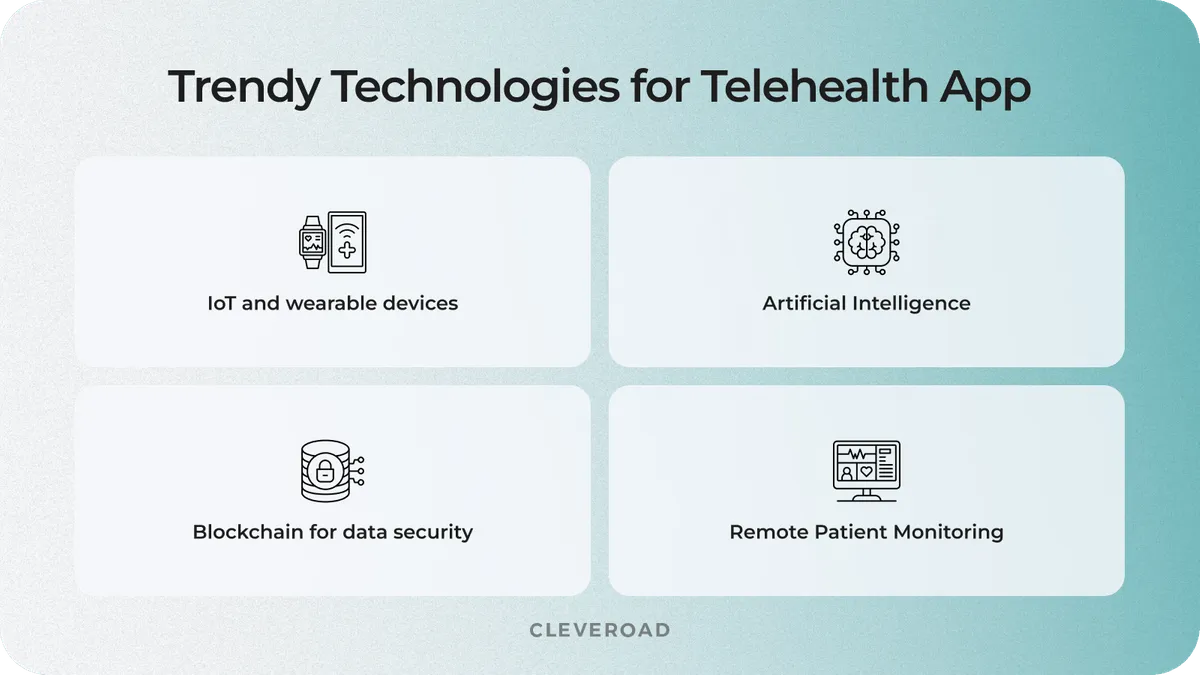
Trends and technologies to implement in telehealth app
IoT and wearable device integration
This technology involves the use of a network of physical objects equipped with sensors and software that communicate with each other and other devices over the internet. IoT in healthcare can be used to monitor patient health, send data to doctors and get recommendations. For example, smart watches can measure heart rate and fitness bracelets can measure activity levels, transmitting this data to the mobile app for further analysis and diagnosis.
AI/ML
These technologies allow computers to analyze large amounts of data, extract useful information, and make predictions based on that information. In telemedicine application development, AI and Machine Learning in healthcare can be used to diagnose diseases, provide personalized medical advice, and predict patient health. For example, machine learning algorithms can help doctors diagnose cancer in its early stages and predict possible complications in patients with chronic diseases.
Blockchain for data security
Blockchain is a decentralized database in which data is stored in blocks linked together and protected cryptographically. Advanced telehealth medical app development requires blockchain to store electronic medical records (EMRs) and ensure the security and privacy of patient medical data. For example, blockchain can be used to ensure that patient data is protected from unauthorized access and to enable secure transfer of medical data between different participants in the healthcare system.
Remote Patient Monitoring (RPM) integration
This technology allows patients to measure their medical conditions and transmit them to their doctors without having to visit a hospital or clinic. In telehealth system development, a remote patient monitoring can be integrated to monitor patients' health conditions and provide information to physicians for decision-making. For example, patients can measure blood pressure or blood glucose levels using specialized devices, and the data can be automatically transmitted to doctors via a mobile app for analysis and further health monitoring.
Cleveroad Expertise in Telehealth App Development
Cleveroad is a healthcare software development company with 12+ years of experience in this industry. We are helping clinics, healthcare establishments, medical device manufacturers, and other health-related businesses to improve caregiving services, daily operations, and clinical data management by creating custom software solutions.
As a part of our healthcare software development services, we build telemedicine platforms, Remote Patient Monitoring (RPM) solutions, EHR/EMR systems, e-prescribing software, Healthcare CRMs, hospital management software, etc. We have confirmed mature quality management through ISO 9001 certification to ensure your software meets quality standards. The ISO 27001-certified security management is based on established policies and processes to ensure data security.
By cooperating with us, you will receive a wide range of benefits:
- Deep healthcare software development expertise: web and Mobile software development, legacy software modernization, cloud development, UI/UX design services, DevOps services, etc.
- Experience in implementing healthcare tools and integrations with telemedicine apps to optimize development time and budget, including Kareo, Athenahealth, MedlinePlus, Twillio, Stripe, etc.
- Expertise in healthcare data security: we implement robust measures such as industry-standard data encryption at rest and on client devices, RBAC to limit access, MFA, and automatic logouts
- Proficiency in creating telemedicine software solutions complying with industry regulations and standards, such as HIPAA, GDPR, HL7, PIPEDA, FDA, HITECH, CDA, etc.
- Free Solution Workshop stage to connect your healthcare business needs with technical implementation. Our healthcare domain experts understand your medical processes and tailor telemedicine software to align with your project's goals, helping you navigate how much does it cost to implement telehealth and ensure a cost-effective solution.
Create telemedicine app with domain experts
Our team with 12+ years of experience in telehealth app development is ready to build a custom telemedicine solution for you to improve your medical services provision
A telemedicine platform is a digital infrastructure that enables healthcare providers to deliver remote medical services to patients through virtual consultations, remote monitoring, and other telehealth solutions.
To create a telehealth application, you should pass these steps in cooperation with a reliable software vendor:
- Step 1. Find a reliable healthcare software development team
- Step 2. Share your health app requirements with the development team
- Step 3. The specialists conduct detailed telehealth requirements analysis and create a feature list
- Step 4. The development team build your telemedicine platform and test it to ensure smooth performance
- Step 5. The specialists deploy you telehealth app to make it available for users
- Step 6. Your software vendor provides you with further support and maintenance services
The cost to develop a telemedicine app varies between $150,000 to $300,000+. Such range is explained by various factors that affect the cost, like complexity, features, platforms, and development team rates.
Creating a telehealth app facilitates convenient access to healthcare services from anywhere, streamlines communication between patients and healthcare providers, efficiently manages medical records and appointments, offers cost-effective healthcare solutions, enhances patient engagement and satisfaction, and aligns with modern healthcare practices and technological advancements.

Evgeniy Altynpara is a CTO and member of the Forbes Councils’ community of tech professionals. He is an expert in software development and technological entrepreneurship and has 10+years of experience in digital transformation consulting in Healthcare, FinTech, Supply Chain and Logistics
Give us your impressions about this article
Give us your impressions about this article